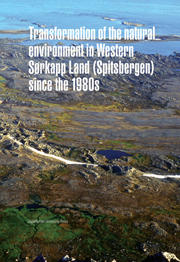Book contents
- Frontmatter
- Contents
- Introduction
- Study area
- Methods and materials
- Components of natural environment
- Environmental and landscape changes
- Climate warming
- Glacial recession
- Transformation of landforms and Quaternary deposits
- Changes of water drainage and networks
- Changes in vegetation
- Conclusions and prognosis for environmental change
- References
- List of enclosures (maps)
- Plate-section
Changes of water drainage and networks
from Environmental and landscape changes
Published online by Cambridge University Press: 05 September 2014
- Frontmatter
- Contents
- Introduction
- Study area
- Methods and materials
- Components of natural environment
- Environmental and landscape changes
- Climate warming
- Glacial recession
- Transformation of landforms and Quaternary deposits
- Changes of water drainage and networks
- Changes in vegetation
- Conclusions and prognosis for environmental change
- References
- List of enclosures (maps)
- Plate-section
Summary
Climate warming has led to an increase in the quantity of liquid water in the Sørkapp Land natural environment due to more intensive ablation of snow patches and glaciers, and the deepening of the active layer (with ice) above permafrost.
This water flows to the sea in streams and rivers (up to 10 km long), under the ground in the active layer of the Quaternary deposits, and under the ground through rock fissures and karst channels. Surface and underground streams carry much more water today than in the 1980s. However, the soil and the surface are generally more dry in the lowland areas between the streams today due to the deepening of the active layer above the permafrost.
The river and lake network changed the most due to glacier recession.
Ice-dammed Goësvatnet lake disappeared due to the recession of Gåsbreen glacier. Its water table became lower and its surface decreased due to the thinning of the glacier tongue, which dammed the valley over time. However, the glacier did not become shorter and the lake persisted until 2000. After 2000, recession further shortened the glacier, removing the natural glacial dam, as detected in 2005 (Ziaja, Ostafin 2007). A large river flows from the upper part of the valley through the former lake's trough and is supplied below by water from Gåsbreen glacier (Figs 11, 12). A few smaller ice-dammed lakes disappeared as well.
- Type
- Chapter
- Information
- Transformation of the Natural Environment in Western Sorkapp Land (Spitsbergen) since the 1980s , pp. 67 - 68Publisher: Jagiellonian University PressPrint publication year: 2011



